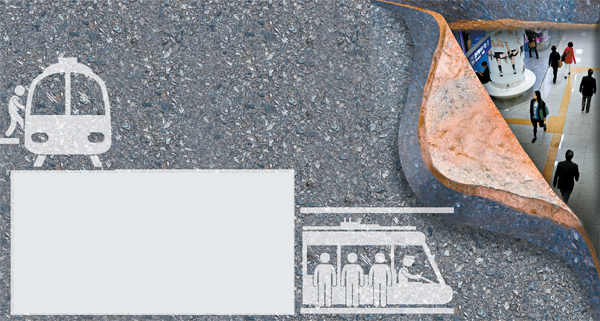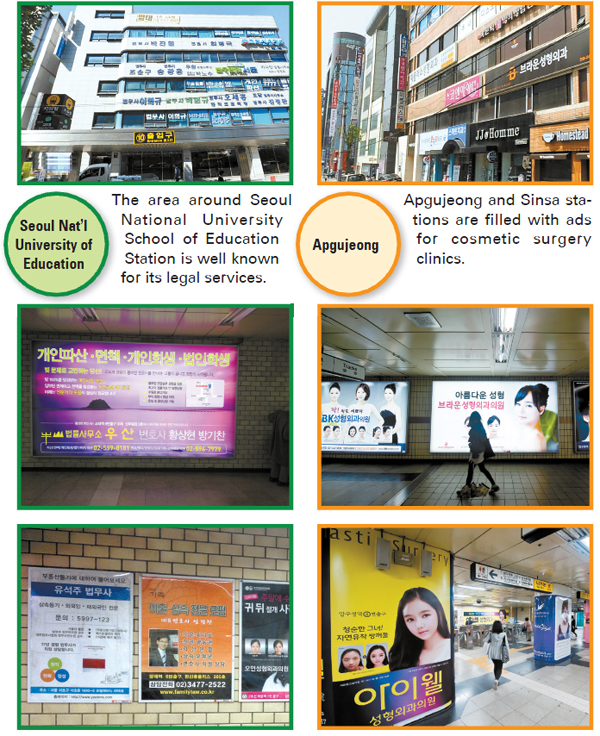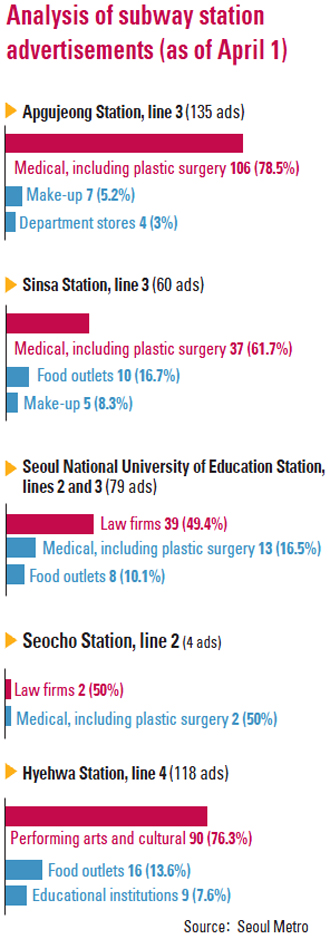Underground ads, above-ground life

Posters placed at a subway station say a lot about the districts surrounding it. By Kim Kyung-rok
But while advertising is ubiquitous, there is something different about ads at subway stations. Unlike ads on TV or in newspapers, subway station ads are localized, placed strategically with a specific target market in mind.
“These ads reflect the commercial activity surrounding that particular station,” said Shim Sung-wook, a professor of advertising and public relations at Hanyang University. Accordingly, a lot can be deduced about a neighborhood from the ads placed at its metro station.
The JoongAng Ilbo explored the underground network in Seoul to find how these ads differ around the city.
Like every metro station, Seoul National University School of Education Station (also known as Gyodae Station), which is located in the south of Seoul where lines 2 and 3 cross, is decked out in ads. But the ads here are a bit different than other stations. Every other term used seems to be something legal, like “divorce,” “liability,” “medical law” or “criminal law.”
Especially near exits 6, 7, 10 and 11 there is a high concentration of ads promoting law firms and their area of expertise.
Although the station is named after a well-known university, this part of the city is more famous for being the home of the Seoul High Court and Seoul Central District Court as well as countless law firms.

With help from Seoul Metro, which operates subway lines 1 to 4, we analyzed subway ads around the city. At Gyodae Station, 39 of the station’s 79 ads - nearly half - are related to legal services.
“Gyodae and Seocho stations are both close to the courts, which explains the ads,” said a Seoul Metro representative.
Just a couple of stops away on the No. 3 line, the subway ads change remarkably. At Apgujeong and Sinsa stations, plastic surgery and medical clinics dominate. At Apgujeong Station, 106 out of 135 ads relate to pharmaceuticals and medical clinics, or nearly 80 percent. At Sinsa Station, 37 out of 60 ads are for pharmaceuticals or surgery.
“Most of these medical ads on posters are cosmetic surgery ads,” said the Seoul Metro representative.
The results are not all that surprising given that Apgujeong-dong and Sinsa-dong have the highest concentration of cosmetic surgery clinics in the country - of the 479 cosmetic surgery clinics and dermatologists in Gangnam District, 256 are here.
Hwang Jang-seon, a professor in the department of advertising and public relations at Chung-Ang University, said that subway ads are “the most selective marketing strategy that a retailer can implement.
“For retailers that don’t have a lot to spend, these ads offer maximum exposure for a relatively low price,” said Hwang.
While deciding on the right place for legal help and cosmetic surgery is usually the result of intensive research and analysis by consumers, Hwang said in places like Seoul National University School of Education and Apgujeong, these ads lure in consumers who can’t tell the difference between one option and the next.

“Due to building restrictions most businesses have a limit of two signs outside. But if they rent out a space at a subway station, they are getting an additional signage and leverage over their competitors.”
When it comes to the fierce competition for the consumers’ gaze, the art world is no exception, as Hyehwa Station on line 4 exemplifies. The Hyehwa area has long been known for its many small and midsize theaters, so naturally the ads in this station tend to revolve around their latest offerings. Of the 118 ads at the station, 90 of them are related to plays and musicals.
From these results, the logical assumption would be that bus stops should yield similar results as the subway, but this was not the case.
Locality-specific ads are more of a subway practice, in part because the cost of bus stop ads is higher.
In addition, for bus stop ads there are stricter rules. To place one ad at a high-traffic area, you must buy at least 10 other spots around town (with a maximum of two spots in the Gangnam area).
Just one bus stop ad costs around 16 million won ($15,411) per month, far more than the three million won that a subway ad costs.
Lee Yoon-sung from the advertising agency Grida Partners said that the high cost of bus stop ads is the main reason why they usually go to big-name brand clothing, sports and beverage companies.
While subway ads go more frequently to small- to medium-sized businesses in the area, this wasn’t always the case.
“Ten years ago conglomerates would use the subway to advertise their brands and products,” said Lee. “It’s only in recent years that local businesses have taken over those spots.”
Change came with the opening of line No. 5 in 1995, and then with lines 6 and 7.
With more subway lines and more stations, conglomerates realized they had to spend a lot more on advertising to get the same effect. Add new media and mobile phones into the mix and there were many more options for big businesses to spend their advertising dollars on.
“With the increase of stations and lines, metro ads proved to be less successful than before,” said Park Hyun from the digital signage department at CJ Powercast. “Furthermore, conglomerates thought that 2-D ads looked out of date and started to look elsewhere.
This is when smaller businesses stepped in. Take, for example, Yeouido Station, on Yeoui Island on the Han River, which is home to one of the biggest clusters of banking and financial firms in Korea. But despite being “the Wall Street of Korea,” few financial companies have ads in this station.
Another interesting phenomenon related to underground advertising is the ads placed by celebrities’ fan clubs. These ads aren’t necessarily there to advertise anything in particular, and often they consist of just congratulatory messages for singers and actors.

Because this part of Seoul is home to SM Entertainment, JYP Entertainment, Cube Entertainment and many other major management companies, fans and tourists from abroad flock here, hoping to catch a glimpse of their favorite stars.
Other popular sites for celebrity ads are parts of town that attract young people, including Myeongdong Station on line No. 4 and several stations on line No. 2 like Hongdae University Station, Wangsimni Station and Konkuk University Station.
“We don’t even know who finances these messages,” said a spokesperson from SM Entertainment.
Although different parts of Seoul tend to attract different ads, the underground ad network is constantly changing. New ads that went up in February on lines 5 to 8 - the lines operated by Seoul Metropolitan Rapid Transit Corporation - were led by gaming with 80, then medical clinics with 56 and movies with 38.
But although movies were third, a subway official said that movie ads are probably the highest-profile advertising, “because when a film takes out an ad, they advertise along the entire line, so it’s probably viewed the most,” said the representative. “But the downside is that these ads run for a shorter duration.”
CJ’s Park agreed that, rather than using it for “branding effects,” metro ads were the most powerful marketing tool for delivering a message in a short time frame. “Movies, shows and universities targeted toward a certain time are most popular,” said Park.
As for medical clinics, Kim Jin-gu, who oversees marketing for Seoul Metro, said that subways tend to be located around business hubs, so they get a lot of hospitals, too.
“Most of these ads target those who live in the area and travel to and from work by the subway,” said Kim.
By Cho Han-dae [carlasunwoo@joongang.co.kr]










with the Korea JoongAng Daily
To write comments, please log in to one of the accounts.
Standards Board Policy (0/250자)